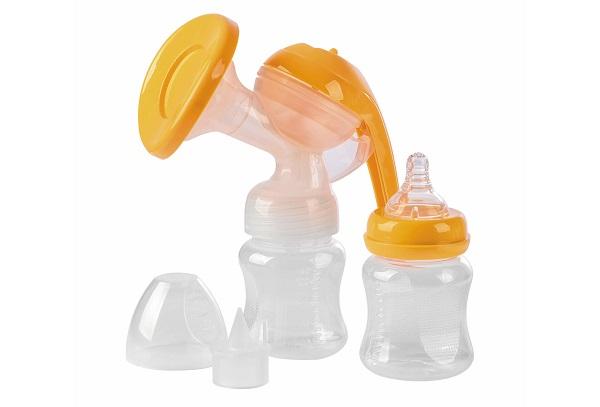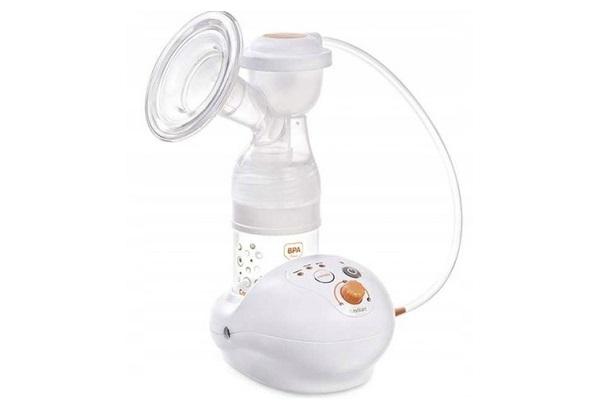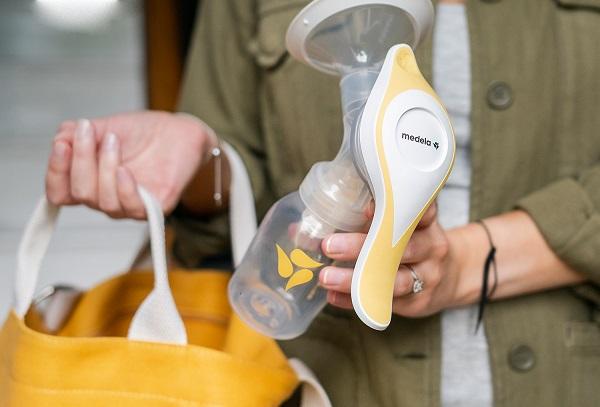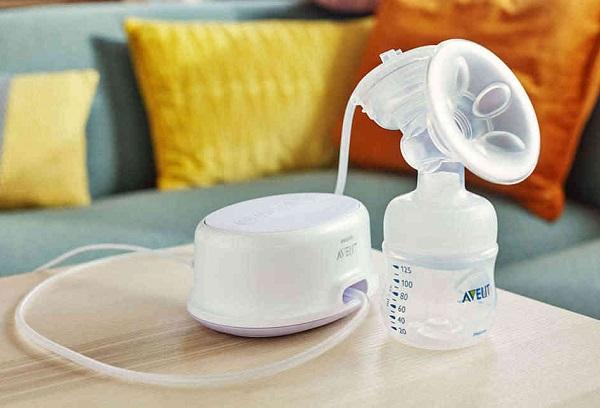Which breast pump is better: manual or electric? Recommendations for selection
When making a list of things to take to the hospital, more and more women are including a breast pump. This simple, but at the same time necessary device allows you to solve a number of problems at once:
- Establish the lactation process as quickly as possible.
- Increase the level of milk produced.
- Prevent the development of mastitis and lactostasis.
Before purchasing, you need to decide which breast pump option is preferable: manual or automatic. There is no clear answer to the question which one is better, everything is individual. It is necessary to proceed from the operating principle of these models, the main advantages and disadvantages.
What is a manual breast pump
A manual breast pump comes in the form of a special attachment that fits tightly onto a bottle for expressing milk.

The main elements of the device are:
- massaging nozzle;
- membrane on which the handle is attached;
- body with a cone-shaped protrusion for the chest (bell);
- a cover designed to protect the breast pump from debris and dust getting inside.
The principle of operation of a manual breast pump is as simple as possible: the bell is applied to the breast and by pressing the handle a vacuum is created in the cone-shaped protrusion, due to which milk is expressed.
What is an electric breast pump
Externally, an electric breast pump resembles a manual one, but it does not have a handle that must be pressed to express milk.Instead, the device is equipped with a compact motor and a power regulator. The motor pumps air through a tube that connects the nozzle and the membrane, due to which a vacuum is created in the nozzle and the milk is expressed without any physical effort.
The breast pump consists of the following components:
- Body with a bell (cone-shaped container for the chest).
- Membrane
- Massage attachment.
- Cover (not available on all models).
- A pipe module that secures the membrane to the tube.
- Tube for air circulation.
- Plastic case with an electric pump that allows you to select the appropriate mode.
What is the difference?
By and large, the operating principle of both manual and electric breast pumps is the same - the liquid is expressed by creating a vacuum in the socket. Only in an electrical appliance this vacuum is provided by a pump. In addition, here you can choose not only the strength of the vacuum, but also the frequency of contractions.
| Manual breast pump | Electric breast pump | |
| Price | From 500 rubles | From 5000 rubles |
| Mode selection | No | Yes |
| Possibility of sterilization | Yes | Yes |
| Noise | No | Yes |
| Compactness | Yes | No |
| Can be used in the bathroom | Yes | No |
| Convenience | Less convenient | More convenient |
Pros and cons of a manual breast pump
Main advantages:
- Compactness. Even with a 60 ml milk bottle, the device takes up no more space than a modern smartphone. The low weight is ensured by the materials from which the breast pump is made (this is safe polypropylene, free of bisphenol-A.
- Budgeting. Compared to an electric breast pump, a manual one has a significant advantage in price and costs 3-4 times less.
- Easy to assemble and maintain. The manufacturer always includes instructions with the device, but even without them everything is clear on an intuitive level. When washing the breast pump, it is not recommended to use sponges or abrasive cleaners to avoid damaging the polypropylene. The body and small parts can be easily cleaned using any liquid soap.
- Independence from electricity. Since the breast pump does not require a power source, you do not have to spend additional money on purchasing portable batteries. To obtain milk, a woman will only need mechanical force.
- Convenient sterilization. A simple mechanism for disassembling the mechanism allows you to quickly disconnect all elements, clean them and sterilize them.
- Replacement of elements. As a rule, the main body is monolithic, since it is very durable and almost impossible to damage. Individual parts (handle or membrane) may become unusable. Manufacturers usually provide the opportunity to purchase replacement parts.
- Silence. Compared to the noise made by an electric breast pump, the manual version is almost inaudible during operation. Mom and baby will only hear the sound of milk being expressed and, possibly, tapping when there is a strong load on the handle.
- Work control. Since the process is based on the use of mechanical force, a woman can completely control the process and stop when the first unpleasant sensations appear, simply by stopping pressing the handle. For example, if you feel discomfort when pressing it fully, you can relieve the pressure by pressing the handle halfway. After just 1-2 pumpings, you can adapt and choose a convenient and comfortable mode.
- Ease of use. Women with large breasts most often suffer from lactostasis, which a breast pump can help cope with. If you use it in the bath or shower, then in combination with hot water it stimulates the dispersal of stagnation in the mammary gland. Before this, it is necessary to express breast milk as much as possible so that you have something to feed the baby. Milk expressed in the bathroom will also have to be thrown away due to the possibility of technical water getting into it. If mastitis has not yet developed, then direct massage with a shower head and a manual breast pump can cope with even complex congestions.
Minuses:
- There is no way to increase pumping strength. Sometimes even maximal pressure on the handle is not enough to express milk. In this case, a manual device will not work; electrical options must be considered.
- Mechanical work. Out of habit, your hand can get very tired, because in order to express milk, you need to press the handle intensely for a certain amount of time. To make the task easier for yourself, it is recommended to take a comfortable lying or reclining position, and also take breaks for a minute to rest your hand.
- Membrane wear. The membrane is perhaps the only weak point in manual breast pumps. Since it is made of soft silicone, damage is common. Even a tiny crack or rupture breaks the integrity of the membrane and helps create a complete vacuum. In such cases, the device will not be able to work at full capacity, this is especially important when expressing the last portions of milk, when you need to put in maximum effort.
- Duration of the process. Since the breast pump can only be used on one breast at a time, this slows down the pumping process.Of course, you can purchase two devices and use them simultaneously on both breasts, but in practice this is of little use. Even when expressing milk from one breast, sometimes you need the help of a second hand.
- A manual breast pump is not intended for prolonged or frequent expression. For example, if a child completely refuses breast milk, the mother will have to express a new portion every 3-4 hours, that is, the load on the hands is very high, because after 5-7 minutes of continuous pressing on the handle of the device, unpleasant and even painful sensations may occur in the hand. Discomfort causes an increase in the level of serotonin in the blood, which, in turn, negatively affects the composition and fat content of the milk produced.
Pros and cons of an electric breast pump
An electric breast pump has a number of advantages over a manual one:
- Speed of work. To express milk, it will take 2-3 times less time compared to a manual device.
- Ease of operation. If a manual breast pump requires dexterity and the use of physical strength from a woman, then an electric one will do everything for her. To express, you just need to thoroughly wash all the elements of the device and connect them. Next, you need to connect the breast pump to a power source (depending on the model, it can be stationary or autonomous), sit comfortably and turn on the device. During the process, you should periodically check that the massage attachment is firmly fixed in place, and also turn off the breast pump in time when there is no milk left in the breast.
- Possibility of choosing a model. Almost all produced breast pumps are available in two- and single-phase variations.
- Ease of cleaning. All elements can be easily detached for washing or sterilization, just like the manual model. It is prohibited to wash only the main body with the electric pump. If it becomes dirty, disconnect the case from the power source and gently wipe the surface with a damp sponge, then wipe dry.
- Possibility to select the operating mode. Modern models cope not only with their main function, but also allow you to prepare your breasts for pumping by turning on the device at low power with increased frequency. It is possible to choose a mode in which milk is expressed to the maximum, freeing up the breast for a new portion. At the highest power, as a rule, the device is practically not used, as this can cause pain, but the ability to select a mode is a definite plus of electric breast pumps.
Flaws:
- Larger size compared to manual models.
- Noise. During operation of the pump, when pumping air, the device produces a characteristic uniform sound. But even at the highest power, the breast pump will not wake up the baby, but, on the contrary, will lull him to sleep with its monotony.
- Requirement of a power source. To function you will need a network or a portable battery. The length of the cord is usually no more than 2 meters, so you need to make sure in advance that there is an outlet near the feeding area.
- Price. The price of electrical appliances starts from 5,000 rubles, and two-phase models will cost an order of magnitude more.
- Expensive repairs. In the event of a breakdown, the device will have to be repaired at prices for household appliances. In some cases, the breast pump cannot be restored at all, for example, if the pump burns out or the microcircuit breaks.
- Limited use. Electrical appliances cannot be used in the shower or bath, as contact with water is not allowed.
What is better to choose
Having studied the disadvantages and advantages of manual and electric breast pumps, you can roughly decide on your choice and understand which option is right for you, as well as study reviews. Undoubtedly, electric models are more convenient and do not require physical strength to operate. However, they are bulkier and noisier and require more delicate handling.
An electronic breast pump is optimal in the following cases:
- Frequent occurrence of lactostasis.
- Complete refusal of the child to breastfeed.
- The need to completely empty the breast when pumping due to poor lactation.
- Sufficient financial resources.
It is better to choose a manual breast pump if:
- You do not plan to use it often, and you will need to express it occasionally.
- The baby sucks well at the breast, but there is not enough milk. In this case, pumping will enhance lactation.
- Saving.
The choice depends only on individual needs, so it is worth studying all the pros and cons of each type of breast pump.


